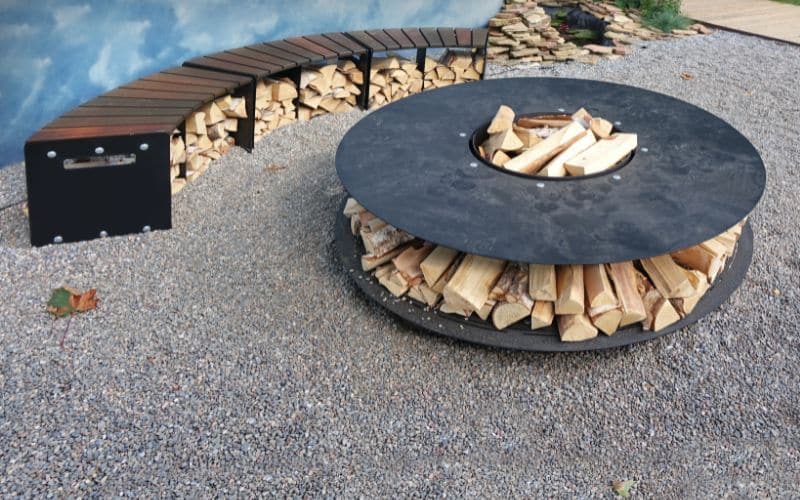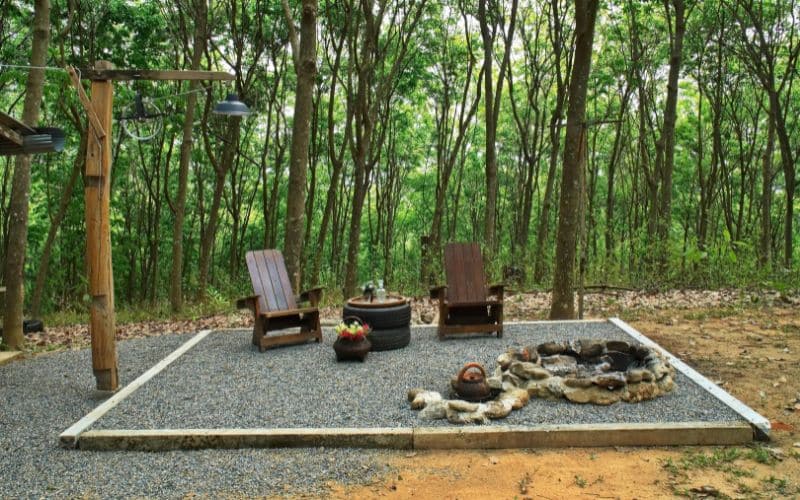
You’re on a mission to create the perfect fire pit area, and one of your top priorities is finding the best gravel. It’s not just about aesthetics; you want to ensure safety and durability too. Gravel, being an essential component in your fire pit set-up, should meet all these criteria.
But with so many options available in the market today, it can be quite challenging to make a choice. You might wonder if there’s really much difference between one type of gravel and another? Well, yes there is! Different types of gravel have distinct properties that can impact how well they perform within a fire pit area.
We’ll guide you through some top picks for fire-pit-friendly gravels that not only look good but also withstand high temperatures while providing excellent drainage capabilities. Whether you’re after something sleek like black lava rocks or prefer more rustic choices such as river rock or pea gravel – we’ve got you covered!
Understanding the Importance of Gravel in Fire Pit Areas
Have you ever wondered why gravel is commonly used around fire pit areas? It’s not just for aesthetics. Gravel plays a crucial role in ensuring the safety and efficiency of your fire pit.
Let’s start by talking about heat resistance. Fire pits can reach extremely high temperatures, and without a suitable protective layer underneath, they could potentially damage your patio or garden area. This is where gravel steps up to the plate! Its ability to withstand intense heat makes it an ideal choice for lining the base of your fire pit.
Next on our list is drainage. The unpredictable Canadian weather means that rain can strike at any time – even when you’ve got a cosy outdoor gathering planned! Here’s how gravel helps: it doesn’t absorb water like soil does, instead allowing rainwater to drain away quickly from the fire pit area. So even if there’s been heavy rainfall, with good quality gravel around your fire pit you’ll be ready to light up as soon as skies clear!
Safety should always be at forefront when dealing with open flames – that’s something we all know too well! You’ll find that most types of decorative stones or pebbles can crack or explode under high heat due to trapped moisture inside them; this poses a real hazard during use but guess what? Not with GRAVEL! It’s one material which remains stable under such conditions making it safe and reliable.
Last but certainly not least, let’s talk maintenance – everyone wants an easy life right? Well here again comes another feather in cap for our dear friend ‘gravel’. Unlike other materials which may need regular cleaning or replacements after being subjected to ash and soot fallout from burning logs- all that’s needed mostly with gravels are occasional raking through!
So next time someone asks why there’s this seemingly odd mixture surrounding their flame hub- now YOU know exactly what magic lies beneath those tiny rocks!
Evaluating Different Types of Gravel for Your Fire Pit
Choosing the right gravel for your fire pit area is a crucial decision you’ll have to make. It’s not just about aesthetics, it also impacts the functionality and safety of your fire pit. Let’s dive into some common types of gravel used in fire pits.
Pea Gravel: Pea gravel is an affordable option that’s easy on bare feet and looks great with any outdoor décor. Its small size allows water to drain through, preventing puddling around your fire pit area.
River Rock: River rock is a bit more expensive than pea gravel but its smooth and often multi-coloured surface makes it a popular choice among homeowners looking to add flair to their exterior spaces. However, do note that river rocks can sometimes explode when heated due to trapped moisture inside them.
Crushed Granite: This type of stone offers sharp edges which can be advantageous if you’re looking for added grip or traction in your outdoor space. It’s durable, holds heat well but doesn’t reflect light as much as other options – making crushed granite ideal if you prefer subtle elegance over flashy aesthetics.
Lava Rocks: If we’re talking about heat resistance then lava rocks top the list! They absorb and distribute heat evenly while resisting high temperatures – making them perfect for intense fires.
Here’s a quick comparison table:
| Type | Price | Aesthetics | Safety |
|---|---|---|---|
| Pea Gravel | $ | Excellent | Good |
| River Rock | $$ | Exceptional | – |
| Crushed Granite | – | – | – |
| $ Lava Rocks | $ $$$-$$ | – |
It’s important when selecting any type of stone or rock material that you consider both form (how it looks) AND function (how it performs). While one may look appealing at first glance, it might not perform well in the context of a fire pit – potentially causing safety hazards or long-term maintenance issues. So, take your time and make an informed decision based on your needs and preferences.

The Top Contenders: Best Gravel Choices for Fire Pits
If you’re planning to enhance your outdoor living space with a fire pit, the type of gravel you choose can play an integral role in creating the perfect ambiance. Let’s dive into some of the top choices.
Pea gravel is often at the top of many homeowners’ lists. It’s small, rounded and comes in various shades from white to brown. Pea gravel provides excellent drainage while also being quite attractive and affordable.
- Pros: Affordable; offers good drainage; aesthetically pleasing.
- Cons: Can shift underfoot or furniture; not ideal for larger fire pits due to size.
Next up, we’ve got crushed granite. This is a robust choice if you’re after durability and longevity for your fire pit area. Its sharp edges offer stability that pea gravel may lack, making it less likely to move around underfoot or beneath chairs.
- Pros: Durable; stable underfoot.
- Cons: More expensive than other options like pea gravel; requires occasional maintenance as it can compact over time.
River rock is another popular option due to its smooth texture and variety of colours available – from earthy browns and greys through vibrant blues or greens!
- Pros : Smooth texture makes it comfortable underfoot; wide range of colours available
- Cons : River rocks retain heat which could potentially cause them to crack over time when used near high temperatures (like those found within a fire pit).
Lastly but definitely not least on our list – lava rock! This lightweight yet durable material adds a unique aesthetic appeal thanks its deep red colouring plus it’s highly resistant against extreme temperatures thus ensuring your fire pit stays intact season after season!
- Pros: Lightweight yet durable material suitable even in harsh weather conditions.
- Cons: Lava rocks are more expensive compared with other types of gravel.
Selecting the right gravel for your fire pit area is not just about practicality, it’s also a chance to add a personal touch to your outdoor space. Remember, each type of gravel has its pros and cons, so consider what’s most important for you before making a choice.
How to Properly Install Gravel in Your Fire Pit Area
Installing gravel in your fire pit area isn’t just a matter of pouring it out and hoping for the best. There’s an art, or perhaps more accurately, a science to it. Follow these steps and you’ll be enjoying cosy fireside evenings before you know it.
First things first – prepare the area. You’ve got to clear any debris from the spot where your fire pit will sit. That means removing leaves, sticks, rocks – anything that could interfere with proper installation.
Next up is marking out your space. It’s vital that you’re clear on exactly where your fire pit will be situated before moving onto adding layers of sand and gravel.
Now we’re onto layering! Start by laying down around 2 inches (5cm) of sand as this helps drainage and provides a solid base for the gravel which will follow shortly afterwards.
Time for the main event: adding the gravel itself! We recommend using 1 inch (2-3 cm) round pebbles or crushed rock – they won’t move underfoot as much as larger stones can do when walking over them frequently.
| Material | Depth |
|---|---|
| Sand Layer | 2 inches / 5cm |
| Gravel Layer | Depends on type |
Finally, compact everything down with either manual pressure or even better if available; hire a mechanical compactor from your local hardware store – this ensures stability within all seasons especially through Canadian winters!
Remember throughout all stages: safety comes first! Wear appropriate PPE such as gloves during installation process because despite its beauty once finished; sharp edges are present at every turn while setting up correctly initially.
Concluding Thoughts on Selecting the Best Gravel for Your Fire Pit
When it comes to creating a fire pit area that’s both functional and aesthetically pleasing, choosing the right gravel plays a significant role. You’ve learned about various types of gravel, their unique qualities, and how they can enhance your outdoor space.
It’s important to remember that size does matter when you’re selecting gravel for your fire pit area. Small pebbles may be more comfortable underfoot but larger stones have a rustic appeal and are less likely to scatter.
Remember also that colour is key in setting the mood of your outdoor space. Darker shades can give an elegant touch while lighter ones create a relaxed atmosphere.
Let’s not forget about texture as well – rough-textured stones provide better traction whereas smooth pebbles add sleekness to your design.
Here are some final points worth noting:
- Check local regulations regarding fire pits before starting any project.
- Always consider safety first – ensure there is adequate distance between the fire pit and any flammable materials.
- Regular maintenance will keep your fireplace looking its best – sweep or rake debris away regularly.
So now you’re equipped with all this knowledge! Choose wisely based on what suits both personal taste and practicality in mind. And most importantly, enjoy those long evenings by the warmth of your new beautiful fire pit area!








